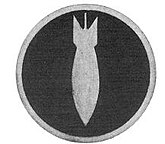Initial activation and involvement in antisubmarine warfare
GHQ Air Force (GHQ, AF) had been established with two major combat functions, to maintain a striking force against long range targets, and the air defense of the United States. [2] In the spring of 1941, GHQ, AF reorganized its Northeast Air District as 1st Air Force. To carry out its mission of training and maintaining a strike force, 1st Air Force organized 1st Bomber Command at Langley Field, Virginia in September 1941, shortly before the attack on Pearl Harbor. The command was originally established to control and train bombardment organizations assigned to 1st Air Force. [1] [note 1] It drew its cadre from the 2d Bombardment Wing, which was inactivated the same day, and whose subordinate units were reassigned to the command. [3] Shortly after the attack, The best trained units in the command moved to critical defense areas or were identified for early shipment overseas. [4]
In November 1941, an increase in German U-boat activity brought a Navy request for reinforcement of Army bomber forces in Newfoundland. In the first week of December, the command dispatched the 49th Bombardment Squadron to meet the Navy request. [5] Then the command's headquarters moved to New York City, New York. [1]
Within a month after the declaration of war by the United States against Germany, German Navy submarines began operating in American coastal waters. By March 1942 fifty-three ships had been sunk in the North Atlantic Naval Coastal Frontier. Defense plans drawn up before the war began assigned the Navy responsibility for operations beyond the coastline, with Army aircraft serving in a supporting role. [6] Because naval aviation that could perform long range patrols was nearly non-existent along the Atlantic coast in early 1942, the burden for aerial antisubmarine patrols fell on the Army Air Forces (AAF), which had available long range and very long range aircraft, [note 2] but whose crews had not been trained for the mission. Moreover, the AAF's long range planes were armed with bombs, rather than depth charges. [7]
As a result, the Commander of the North Atlantic Naval Coastal Frontier requested the Army's Eastern Defense Command to undertake offshore patrols with all available aircraft. The first patrols were performed by elements of I Bomber Command, which would be the primary AAF command involved in antisubmarine warfare (ASW) in early 1942, with assistance from I Air Support Command. However, although I Bomber Command was primarily involved in conducting ASW, it was doing so on an emergency basis, and was subject to withdrawal from these duties to perform its primary bombardment function. [8] The command used Douglas B-18 Bolo and North American B-25 Mitchells to patrol as far out as 300 miles, and Boeing B-17 Flying Fortresses to patrol to 600 miles from shore, but in early operations was only able to maintain six aircraft on patrol. For patrols closer to the shore, the command relied on the civilian pilots of the new Civil Air Patrol. [9]
In March 1942, the command received its first planes equipped with radar. [10] It soon became apparent that if the AAF were to continue with the ASW mission, its units would have to be organized under a specially trained and equipped command. [11] The personnel and assets of I Bomber Command were transferred to the newly created Army Air Forces Antisubmarine Command on 15 October 1942. [1]

